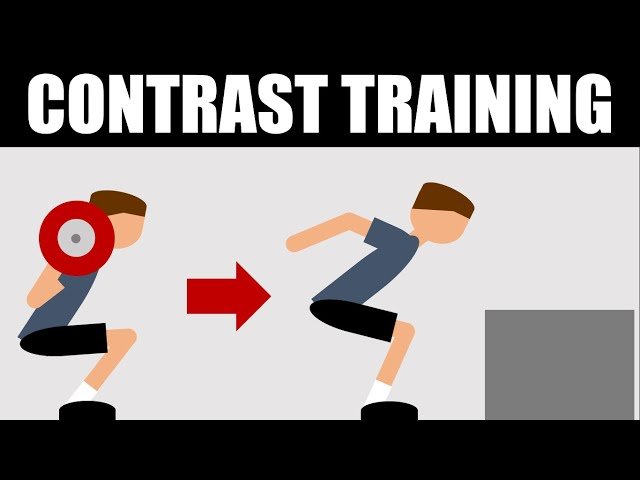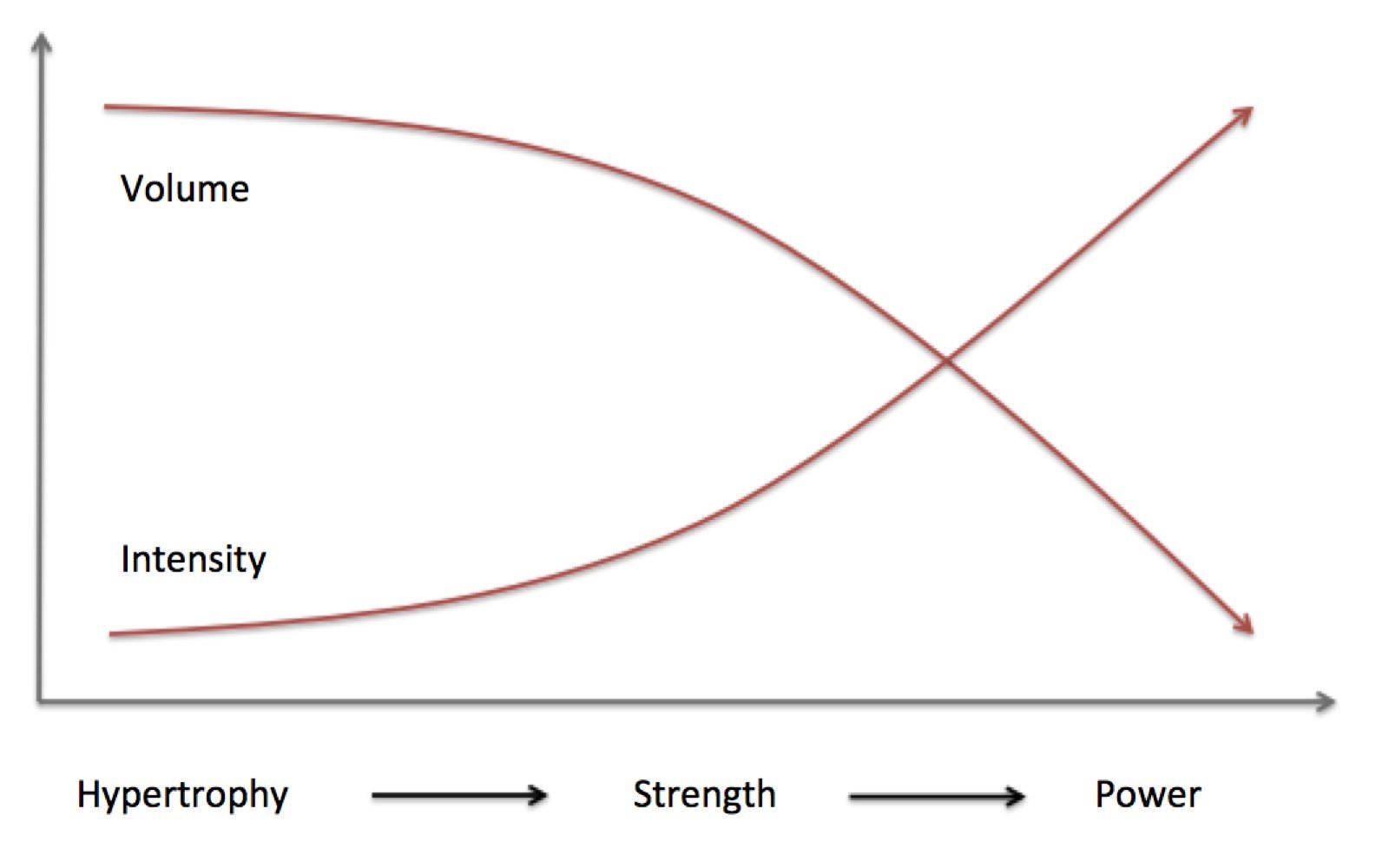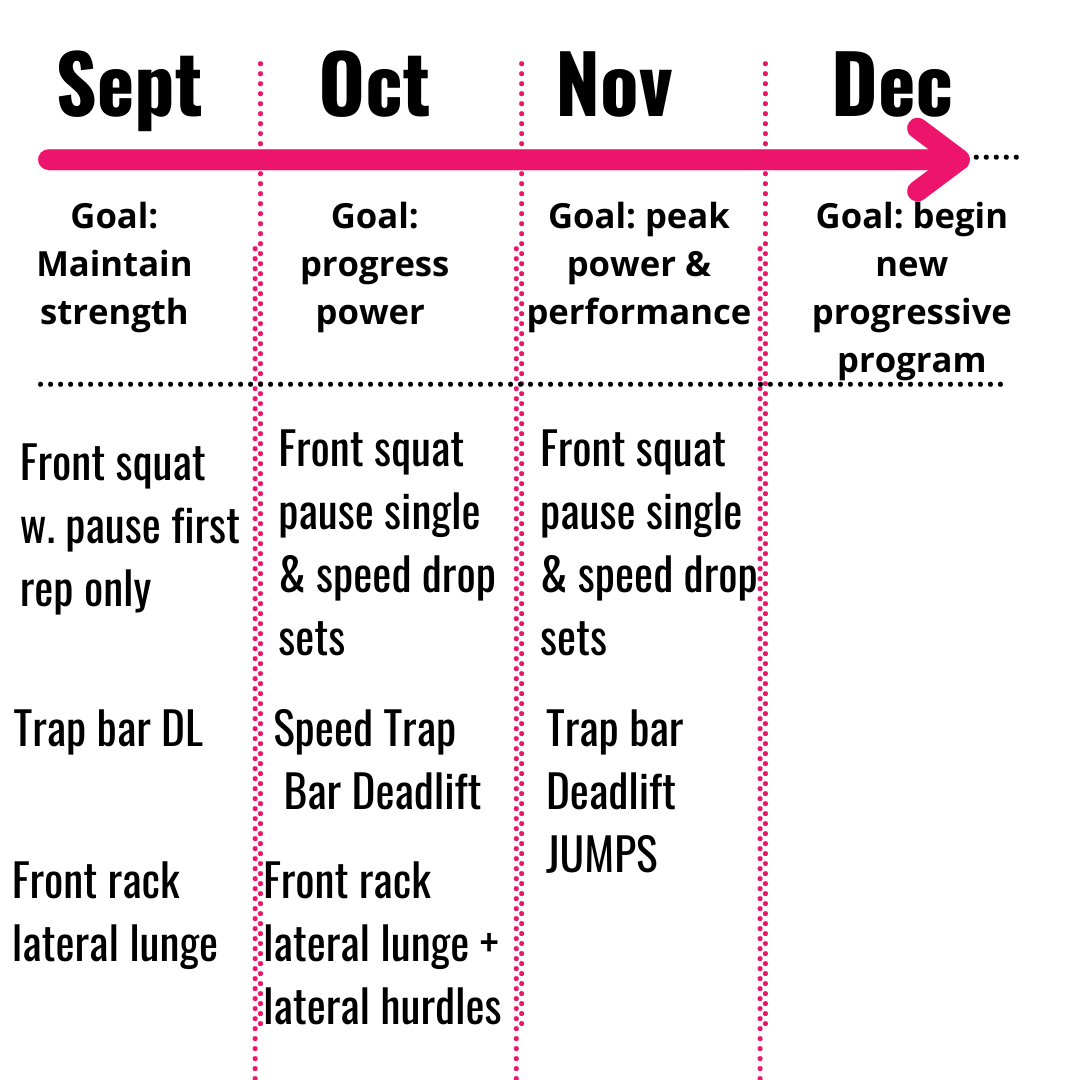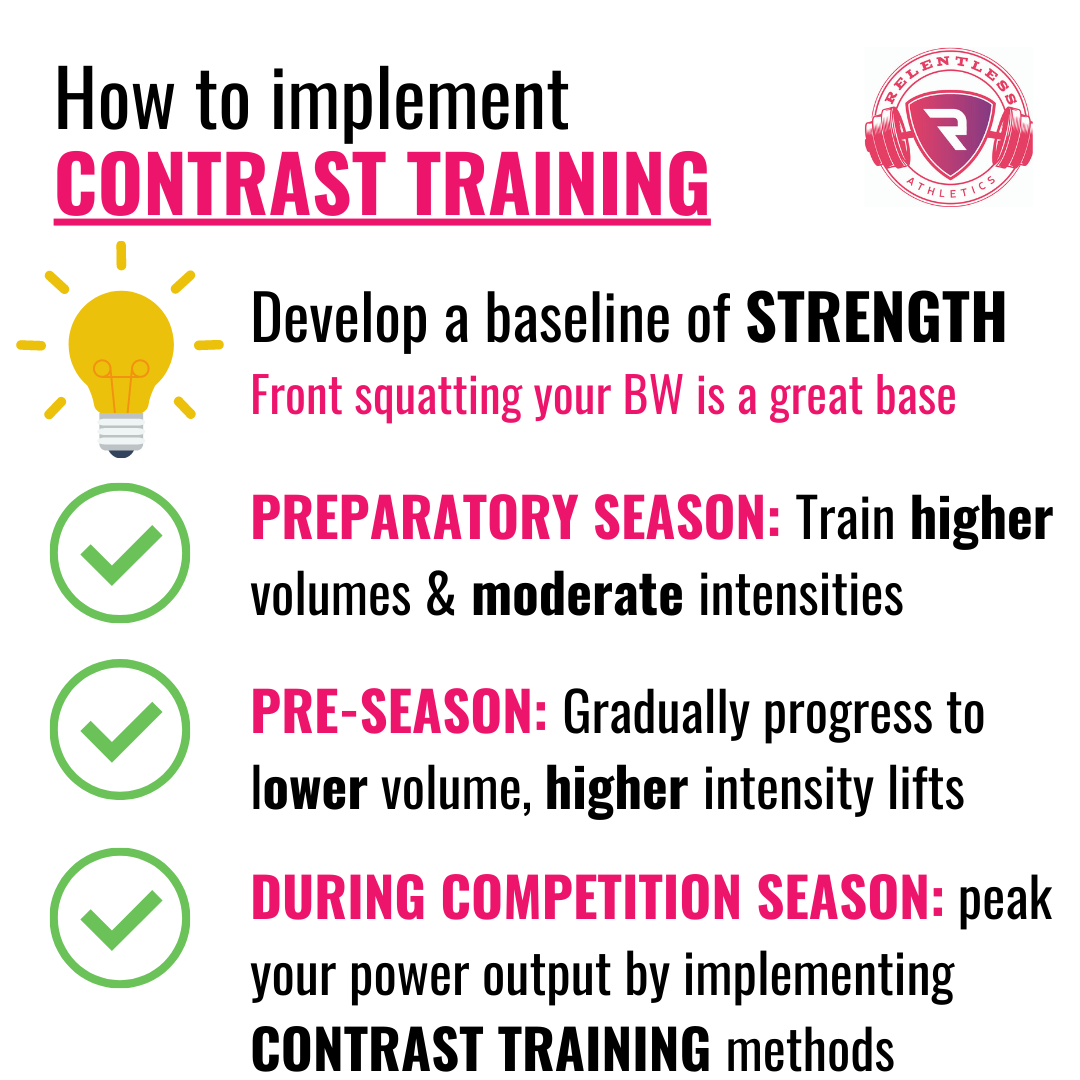How the female athlete can improve her SPEED & POWER
By Lotte Black, MS
Many female athletes (and their parents) want their athlete to sprint FASTER, jump HIGHER, or change direction more EXPLOSIVELY
But what is the MOST EFFECTIVE training to help enhance this POWER OUTPUT?
Contrast Training is an effective modality to enhance a female athlete’s muscular qualities to allow for GREATER POWER OUTPUT
This article aims to explain how contrast training elicits an adaptive response….and what your athlete needs FIRST in order for this method to work:
Contrast Training for IMPROVED POWER
Contrast training is one of the many training methods used in the strength and conditioning field to develop muscular power in athletes.
Contrast training (aka complex training) is defined as the combination of a strength movement and a plyometric movement or a high resistance/high intensity movement paired with a speed based/high velocity movement (1).
Some examples of contrast training commonly utilized in sport performance include but not limited to;
loaded squats paired with box jumps
barbell bench press paired with med ball toss
split squats paired with switch jumps.
The implementation of contrast training is important for athletes in their development of power.
Power is defined as the ability to produce force QUICKLY.
In sport this can be observed through faster throws, harder kicks and increased speed while changing direction.
Research shows that it is not only necessary for athletes of all sports to improve strength but also their POWER (9,11). It is not enough for athletes to only be able to produce HIGH amounts of force rather high force at HIGH VELOCITY.
By implementing contrast training methods within a periodized resistance training program, female athletes can effectively enhance their power outputs & improve their sport performance.
Here’s how:
How CONTRAST TRAINING works.
Contrast training is the combination of the max strength section and the max velocity section of the force velocity curve.
The strength section acts as activation/heavy loading of the muscle prior to the speed section where the athlete elicits quicker muscular contractions (8).
Contrast training improves power production through a physiological adaptation known as post-activation potentiation (PAP).
PAP is a phenomenon by which muscular performance can be temporarily ENHANCED as a result of a previous conditioning activity (4).
In the case of contrast training, performing a HIGH FORCE movement like a back squat, temporarily enhances the motor recruitment ability of the muscle to enhance performance in a FAST VELOCITY movement, like a box jump.
The initial heavy loading recruits a high number of muscle fibers which are then also available for the following explosive exercises (3). The high velocity movement (i.e box jumps) results in a HIGHER force production due to the muscle being conditioned from a previous high load non-fatiguing movement (i.e. Front squat) (4).
Pairing these two movements together leads to increased muscular power, force and rate of force development.
The FOUNDATION of Contrast Training: STRENGTH.
Although contrast training seems to be an optimal type of training for improving power, without the ability to produce high force an athlete’s power will always be low.
This is why athletes need to become stronger before including this type of training into their program (10).
Studies show that this type of training is more effective for individuals who have already developed a significant amount of strength (2,10). Research shows that PAP responses vary in individuals of different strength levels (12).
It has been shown that athletes who have developed their strength will show greater muscle adaptations in response to contrast training since PAP responses are more effective in stronger individuals (7).
Therefore, the addition of contrast training would not be appropriate for beginner athlete due to lack of muscle hypertrophy and nervous system development (10)
Female Athletes NEED to be POWERFUL.
Contrast training is able to translate directly into sports performance since a majority of sports require athletes to be explosive in nature. The development of an athlete’s power output means they are producing high forces at a high velocity (11).
Being powerful helps an athlete by increasing the amount of muscle fibers that fire simultaneously during movement (9), and this in turn has been shown to translate to increases in vertical jump height, sprint acceleration and throwing speed (12,6).
These types of loading patterns are important when athletes are in peak power phases such as during their competition season. This is because less fatiguing (low volume) exercises in combination with higher velocities help maintain strength with limited soreness for improved sports performance.
Additionally, implementing this type of power training in the later phases of a periodized program is important, since it is not efficient to have an athlete training for high power all year round.
Since high power production is more sport specific, peak power phases of a program should be programmed leading up to the athlete’s most important point of the season (i.e. where they want to be in peak shape).
As a result of contrast training studies show an increase in vertical jump height, acceleration and throwing (12,6).
Powerful female athletes coming to a field near you….
In conclusion, contrast training is a type of training that helps improve power and rate of force development which translates into more successful sports performance for athletes.
Through implementing this type of post activation potentiation, exposure to loaded muscle contraction enhances the following movement by activating more muscle fibers through an increased neuromuscular response.
A result of this is a MORE POWERFUL ATHLETE.
Strength is a prerequisite for contrast training to be most effective (i.e. not for beginners).
This is because without an appropriate strength base, contrast training is limited in its ability to enhance power in female athletes.
In order to help female athletes develop POWER for their competitive season, contrast training would be incorporated within a periodized resistance training program.
By progressively overloading a female athlete through phases of muscular endurance & hypertrophy, strength development, and then power development via contrast training, female athletes are able to most effectively enhance their power for their sport when it matters most.
REFERENCES
Gould C. (2021) How to Utilize Contrast Training for Strength, Power and Performance. Personal Training Quarterly, 7(3).
Ebben, WP. (2002) Complex training: A brief review. Journal of Sports Science and Medicine 1(2): 42
Annadurai R., Kalarani A. (2021) Effect of Complex training on Physical Parameters of Volleyball Players. International Journal of Physical Education, Sports and Health 2021; 8(4): 150-153
Robbins D. (2005) Postactivation Potentiation and Its Practical Applicability: A Brief Review. Journal of Strength and Conditioning Research, 19(2), 453-458.
Docherty, D., & Hodgson, M. J. (2007). The application of postactivation potentiation to elite sport. International journal of sports physiology and performance, 2(4), 439.
Tsimachidis, C., Patikas, D., Galazoulas, C., Bassa, E., & Kotzamanidis, C. (2013). The post-activation potentiation effect on sprint performance after combined resistance/sprint training in junior basketball players. Journal of sports sciences, 31(10), 1117-1124.
Seitz LB, Villarreal ES, Haff GG. (2014) The Temporal Profile of Postactivation Potentiation is Related to Strength Level. Journal of Strength and Conditioning Research, 28(3), 706-715.
Lorenz D. (2011) Post-activation Potentiation: an introduction. Int J Sports Phys Ther. 6(3):234-240.
Young, Warren B. (2006) Transfer of Strength and Power Training to Sports Performance. International Journal of Sports Physiology and Performance 1.2; 74-83.
Newton RU and Kraemer WJ. (1994) Developing explosive muscular power: Implications for a mixed methods training strategy. Strength Cond J 16: 20–31.
Haff G., Nimphius S. (2012) Training Principles for Power. National Strength and Conditioning Association; 34(6).
Seitz LB, Haff GG. (2016) Factors Modulating Post-Activation Potentiation of Jump, Sprint, Throw, and Upper-Body Ballistic Performances: A Systematic Review with Meta-Analysis. Sports Med.46(2):231-40


















